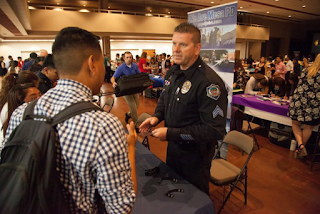 I taught 6th graders in
1995, my first year of teaching. I
taught in a small farming town in Idaho with a large migrant population. It was here that I met my first beloved,
bright Latina student with Spanish-speaking parents. During the parent-teacher conferences, the
supportive Mexican family came and my student acted as the language-broker, who
is a child who translates for parents.
My student was eager to learn and she rose to the top of the class. At the end of the year, at a little class banquet
we created, my student arrived in her finest dress with beautiful ribbons in
her hair. She proudly brought her
parents so they could see some of her completed work. Her mom approached me with a plate of
homemade goods and gave me a tearful hug of gratitude. Dad gave me a huge smile and shook my hand with
all of the energy of his soul. That was
it. I fell in love with first-generation
Hispanic students who worked so hard to create successful lives for themselves and
their families, taking nothing for granted.
I taught 6th graders in
1995, my first year of teaching. I
taught in a small farming town in Idaho with a large migrant population. It was here that I met my first beloved,
bright Latina student with Spanish-speaking parents. During the parent-teacher conferences, the
supportive Mexican family came and my student acted as the language-broker, who
is a child who translates for parents.
My student was eager to learn and she rose to the top of the class. At the end of the year, at a little class banquet
we created, my student arrived in her finest dress with beautiful ribbons in
her hair. She proudly brought her
parents so they could see some of her completed work. Her mom approached me with a plate of
homemade goods and gave me a tearful hug of gratitude. Dad gave me a huge smile and shook my hand with
all of the energy of his soul. That was
it. I fell in love with first-generation
Hispanic students who worked so hard to create successful lives for themselves and
their families, taking nothing for granted.
In fall of 2016 I had the privilege
to teach Izzy in my MCC public speaking course.
Izzy is an older student than my first Latina, but her zeal and
commitment reflect similar cultural values.
She has overcome many of the same struggles that other first-generation Hispanic college students have encountered, and she happily volunteered to share her inspiring story:
So often it feels like no one could
really understand what you are going through, the struggles as well as the
celebrations. Perhaps you have similar thoughts
to some comments below:
1)
I’m stuck; there is no way out of this situation
2)
I didn’t take the SATs or ACTs in high school
3)
I haven’t earned/saved any money to pay for
college
4)
I didn’t graduate from high school
5)
I can’t stop working to enroll in school because
not only do I need the job to pay for school, much of the money I earn goes
toward helping the family. I can’t
afford to work less
6)
I’m too old to go back to school, and I didn’t
do that well in high school anyway
7)
I need to have income tax returns to apply for
financial aid, and that is difficult for my family
8)
My parent(s) are working so much, it seems wrong
to add another layer of stress to the home
9)
I don’t want to be one of the few Hispanics at
such a big school
10)
My parents don’t know anything American college,
so I would have to figure it all out on my own
11)
I know I can’t do labor, but I don’t know what I
would study in school
12)
There are so many degrees and certificates, and
I don’t even know what it all means
I'm First! is an online community for first-generation college
students—and their supporters. Hear inspiring stories and share your own, find
answers to your questions about college, and receive guidance on the road to
and through college.
Watch the following video from an ASU Latina student whose
mom did not speak English and who fought homelessness and alcoholism. “There is a future, so don’t get discouraged
and go out and apply for scholarships, because you never know!” I’m
First!:
First-generation college students extend beyond the Hispanic
community. Our former President and First
Lady, The Obamas, were I’m First!
You are not alone, and there are many who can help and
support you. Check out some of the 105 I’m First! videos, and you can view
other Phoenix students who have successfully overcome many of the situations
you face:
I have loved connecting with my Latino population one
student at a time, and now I am reaching a little further. I know that education will change your life
and the life of your family – all you need to do is take the first step. Ask for help.
Reach out to a professor/teacher or a school counselor. The fear will vanish as you see your goals
come into view.























